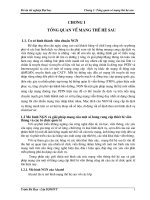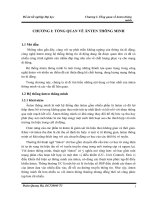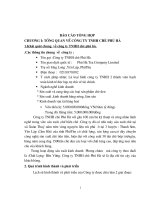Bond- Tổng quan về trái phiếu
Bạn đang xem bản rút gọn của tài liệu. Xem và tải ngay bản đầy đủ của tài liệu tại đây (225.54 KB, 17 trang )
TABLE OF CONTENT
A. INTRODUCTION .................................................................................................................. 2
I. OVERVIEW OF BOND .......................................................................................................... 3
1. Definition .................................................................................................................................................... 3
2. Features of bond ......................................................................................................................................... 3
2.1. Par value/ Face Value/ Principal ............................................................................................................. 3
2.2. Coupon .................................................................................................................................................. 3
2.3. Maturity date ........................................................................................................................................... 3
2.4. Bond pricing .......................................................................................................................................... 4
2.5. Credit rating .......................................................................................................................................... 5
(Source: Fundamentals of Investments, Charles J. Corrado, Chapter 11, page 33) ...................................... 8
2.6. Callability .............................................................................................................................................. 8
2.7. Putability ............................................................................................................................................... 8
3. How are bonds different from stocks? ......................................................................................................... 8
II. INSTITUTION ISSUING BONDS ....................................................................................... 9
1. Government bonds ...................................................................................................................................... 9
2. Municipal bonds ......................................................................................................................... 10
3. Corporate bonds ....................................................................................................................................... 10
3.1. Definition ............................................................................................................................................... 10
3.2. Advantages of bond financing over a bank loan .................................................................................... 10
3.2.1 Fixed Interest Rate .............................................................................................................................. 10
3.2.2 Long-term Loan, Fully Amortized ....................................................................................................... 11
3.2.3. Open-ended Mortgage ....................................................................................................................... 11
3.2.4. Liberal Prepayment Provisions ........................................................................................................... 11
3.3. Type of corporate bond .......................................................................................................................... 12
3.3.1. Secured bond ..................................................................................................................................... 12
3.3.3. Convertible bond ................................................................................................................................. 12
3.3.4. Junk bond ........................................................................................................................................ 13
3.3.5. Zero coupon bond ........................................................................................................................... 13
3.4. Requirements ......................................................................................................................................... 13
III. RISK OF INVESTING IN BONDS .................................................................................. 14
1. Interest Rate Risk ...................................................................................................................................... 14
2. Inflation Risk ............................................................................................................................................. 14
3. Default Risk .............................................................................................................................................. 15
4. Rating Downgrades .................................................................................................................................. 15
5. Liquidity Risk ............................................................................................................................................ 15
IV. WHY BUYING BOND? ..................................................................................................... 16
1. Income predictability ................................................................................................................................ 16
2. Safety ........................................................................................................................................................ 16
3. Choice ....................................................................................................................................................... 16
B. CONCLUSION: .................................................................................................................... 16
C. REFERENCES ..................................................................................................................... 17
1
A. Introduction
Nowadays, in whatever economic types, the capital always plays an extremely
important role. It is not only important in day-by-day needs but also in many aspects of
the real life.
With business organizations, they need capital to buy or lease real estate for placing the
factory, the office, the inventory goods…; to purchase materials for producing
merchandise; to distribute the merchandise from producers to consumers, to pay for
employees, etc. So how they can obtain the needed capital for their business? There are
many ways to raise capital such as: mortgage assets, borrowing from the financial
institutions or banks, issuing stocks or bonds, etc.
With government, they need capital to do the government projects, to do profit or non-
profit activities, etc. So how they can do it? Increasing any types of taxes? Increasing
the price of products which are under the management of the government? Borrowing
from other countries? Selling the real materials abroad with the low price? Issuing
stocks or bonds? etc.
With many people who have free-cash and want to use it usefully without doing
business, how they can do with their money? Lending? Saving in banks? Buying stocks
or bonds? etc.
They have many ways to choose. They can find the best way which is suitable for their
own situation. However, there are many organizations choose issuing bonds, and many
people choose buying bonds instead of stocks. Why they choose this way? How they
can do it? What are the bonds?
Today, we will introduce about BONDS, a way to raise capital for business
organization, for government and to invest carefully for the investors.
2
I. Overview of bond
1. Definition
Bond is a debt instrument issued for a period of time with the purpose of raising capital
by borrowing. The issuer is the borrower (debtor), the holder is the lender (creditor).
Institutions that sell bond are governments, cities, corporations.
Coupon interest, capital gains and interest on interest (if a bond pays no coupon interest,
the only yield will be capital gains) are the three factors affecting the yield of bond.
2. Features of bond
2.1. Par value/ Face Value/ Principal
The face value (also known as the par value or principal) is the amount of money
printed on the bond, on which the issuer pays interest and the holder will get back when
bond matures.
2.2. Coupon
The interest rate printed on bond expressed as a percentage of the par. It can be paid
monthly, quarterly, semi-annually or annually. The risk and the maturity date will affect
the coupon. The more risk the bond is and the longer the maturity date the bond has, the
higher interest rate is.
2.3. Maturity date
The date when bond comes due and the issuer has to repay principal to the holders.
3
Municipal bonds issued in 2005 in Ho Chi Minh city
2.4. Bond pricing
The real price that investor pay for the bond. It can be higher, equal or lower than the
nominal value. However, whatever the buying price is, the coupon is still determined by
nominal value and the issuer still pay the principal when bond matures.
4
The buying price of bond is opposite with interest rate on the secondary market. When
interest rate increases, the bond price will decrease and when interest rate decreases,
bond price will go up.
Example: a company issues a bond with par value $1000, coupon 8%. After a period of
time:
Case 1: Interest rate on secondary market is 10%. New bond (a bond with
similar characteristics such as credit quality and maturity) coupon is 10%
Instead of holding old bond, investors will use their money to buy new bond.
Therefore, they will sell old bond at price lower than its nominal value to make it
competitive. The 8% bond’s interest payments would have a current yield of 10 % only
if that bond could be bought for $800. Now, the price falls from $1000 to $800 (-20%).
The bond is said to be selling at a discount
Case 2: Interest rate on secondary market is 6%. New bond coupon is 6%
Instead of buying new bond, investors will keep old bond. Therefore, the price of old
bond in the secondary market will increase. The 8% bond’s interest payments would
have a current yield of 6% only if that bond could be bought for $1333. Now the price
goes up from $1000 to $1333 (+30%). The bond is said to be selling at a premium.
2.5. Credit rating
A credit rating evaluates the credit worthiness of a corporation, or a country. Therefore,
a credit rating let a lender or investor know whether the issuer can pay back a loan. If
the issuers have a poor credit rating, they also have a high risk of default or bankrupt,
that leads to high interest rates, or the refusal of a loan by the creditor. The evaluation is
necessary for the investors will be protected.
5
When a corporation sells a new bond issue to investors, it usually subscribes to several
bond rating agencies for a credit evaluation of the bond issue. Each contracted rating
agency then provides a credit rating - an assessment of the credit quality of the bond
issue based on the issuer's financial condition. Rating agencies will normally provide a
credit rating only if it is requested by an issuer and will charge a fee for this service. As
part of the contractual arrangement between the bond issuer and the rating agency, the
issuer agrees to allow a continuing review of its credit rating even if the rating
deteriorates. Without a credit rating a new bond issue would be very difficult to sell to
the public, which is why almost all bond issues originally sold to the general public
have a credit rating assigned at the time of issuance. Also, most public bond issues have
ratings assigned by several rating agencies.
Some rating agencies in the United States are Duff and Phelps, Inc. (D&P), Fitch
Investors Service (Fitch), McCarthy, Crisanti and Maffei (MCM), Moody's Investors
Service (Moody's), and Standard and Poor's Corporation (S&P). Moody's and Standard
and Poor's is considered the two best rating companies. These companies publish
regularly updated credit ratings for thousands of domestic and international bond issues.
Rating agency
Moody’s Duff &
Phelps
Standard
& Poor’s
Credit Rating Description
Investment Grade Bond Ratings
Aaa
Aa1
1
2
AAA
AA+
Highest credit rating, maximum safety.
6







